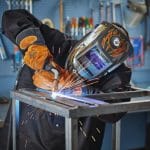The MIG welding process is the most common and popular of all the welding processes. The benefits of the MIG process are immense. It is an effective process for welding and is widely accepted in many industries. It can be automated or manually operated. The MIG welder is a very versatile tool and can be operated to suit the needs of the welder. It is also an effective choice for robotic applications. There are several reasons for its use.
MIG welding uses a cable to transfer heat from the work piece to the filler metal in the joint. The cable is fed with current from the welder’s torch via a copper contact tube. A protective gas is then used to keep the pool and wires from becoming contaminated with spatter, or other materials. A welder’s engine drive cable is connected to the torch and fed from a reel along the connection line. A MIG pool can be cored or solid depending on the material or application.
The main difference between MIG welding and other types of welding is the method used for the welding process. MIG welding is a sonic process, which means that it uses a high-frequency current. The arc is created by a magnetic field and electrical discharge. The magnet is used to create a permanent bond between the metal pieces. In this process, the electrode touches the metal pieces and causes an arc. The wire is melted and filler metal is welded.
MIG welding has several advantages over other types of welding. Its main purpose is sheet metal work, and it is not susceptible to wind or other weather conditions. While the electrodes are generally positive, there is still some manual adjustment needed to control the temperature. The welding current is determined by the feed rate, which is also determined by the feed speed. The burn-off rate of the wire is the key to creating a balance. A well-controlled MIG welding process will be able to create perfect connections with no spatter and no fusion defects. The advantages of MIG welding over TIG are that it is faster. This means that it saves on production costs. The arc is not as clean and precise as a TIG weld. The MIG welder is not recommended for thin materials. However, the MIG welder is an excellent choice for thicker materials. Its high feed rate makes it a viable choice for a wide range of applications.

The MIG welding process is an ideal choice for the fabrication of structural steel parts. The welds produced by this method are more stable than those of any other welding process. They are characterised by a clean arc and a greater degree of flexibility in positions. The MIG process is used to weld steel, aluminium and plastic components. A MIG welder will be required if you need a high-quality weld.
The MIG welder can be fully automated but it still needs manual input to adjust the welder’s settings. Its benefits are largely dependent on the type of arc the welder produces. The MIG welding process is highly versatile, so you can weld any type of metal with it. It is easy to use and can be a cost-effective alternative to a traditional welder.
MIG welding processes have many advantages over other methods of metal transfer. The wire is fed into the arc by a gun with a pointed tip. This is the fastest way to weld a piece of metal, because the MIG welding process requires only a small amount of wire to produce the same level of heat. The MIG welder is also very efficient, resulting in the lowest overall cost of ownership.
Contact us online or call on 01733 686696 to now to discuss your mig welding project requirements or Arc Welding projects.